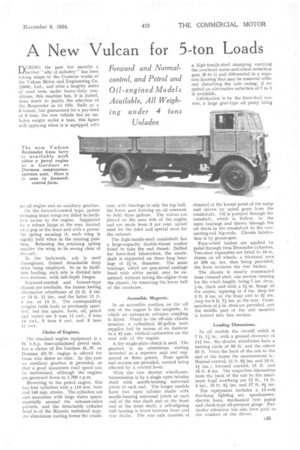A New Vulcan for 5-ton Loads
Page 75

If you've noticed an error in this article please click here to report it so we can fix it.
DURING the past few months a L./further " ally of industry " has been taking shape in the Crossens works of the Vulcan Motor and Engineering Co. (1906), Ltd., and after a lengthy series of road tests under heavy-duty conditions, this machine has, it is stated, done much to justify the selection of the Responder as its title. Built as a 5-tormer, but guaranteed for a pay-load of 6 tons, the new vehicle has an unladen weight under 4 tons, this figure still applying when it is equipped with
an oil engine and all auxiliary gearbox.
On the forward-control -type, patent swinging front wings are fitted to facilitate access to the engine. Supported by a robust hinge at the rear, located on a peg at the front and with a powerful spring securing it, each wing is rigidly held when in the running position. Releasing the retaining spring enables the wing to be swung clear of the cab.
In the bodywork, ash is used throughout, framed detachable drop sides being employed. So as to facilitate loading, each side is divided into two sections, with full-depth hinges.
Forward-control and bonnet-type chassis are available, the former having alternative wheelbases of 12 ft. 3 ins. or 13 ft. 11 ins., and the latter 12 ft. 4 ins. or 14 ft. The corresponding weights (with body as previously specified, but less spares, tools, oil, petrol and water) are 3 tons 11 cwt., 3 tons 14 cwt., 3 tons 9 cwt. and 3 tons 11 cwt.
Choice of Engines.
The standard engine equipment is a 75 b.h.p. four-cylindered petrol unit, hut a choice of the Gardner 4L.W. or Dorman 4H.W. engine is offered for those who desire an oiler. In this case an auxiliary gearbox is provided, so that a good maximum road speed can be maintained, although the engines are governed down to 1,700 r.p.m.
Reverting to the petrol engine, this has four cylinders with a 110 mm. bore and 140 mm. stroke. The cylinders axe cast Jzonobloc with large water space, especially around the exhaust-valve pockets, and the detachable cylinder head is,of the Ricardo turbulent type. An aluminium casting forms the crank
case, with bearings in only the top half, the lower part forming an oil reservoir to hold three gallons. The valves axe placed on the near side of the engine and are made from 3 per cent, nickel steel for the inlet and special steel for the exhaust.
The high-tensile-steel crankshaft has a large-capacity double-thrust washer fitted to take the end thrust. Drilled for force-feed lubrication, the crankshaft is supported on three long bearings of 2.1-in. diameter. The main bearings, which are gun-metal castings lined with white metal, may be examined, without taking the engine from the chassis, by removing the lower half of the crankcase.
Accessible Magneto.
In an accessible position on the off side of the engine is the magneto, to which an automatic advance coupling is fitted. Fixed to the off-side chassis member, a cylindrical 30-gallon tank supplies fuel by means of an Autovac to a 42 mm. vertical carburetter on the near side of the engine.
A dry single-plate clutch is used. The gearbox is an aluminium casting mounted as a separate unit and supported at three points. Four speeds and reverse are provided, control being effected by a central lever.
With the two shorter wheelbases, transmission is by a single open tubular shaft with needle-bearing universal joints at each end. The longer models have two open tubular shafts with needle-bearing universal joints at each end of the rear shaft and at the front end of the front shaft; a self-aligning ball bearing is fitted between front and rear shafts. The rear axle consists of a high-tensile-steel stamping, carrying the overhead worm-and-wheel reduction gear (8 to 1) and differential in a separate housing that may be removed without disturbing the axle casing; if required an alternative reduction of 7 to is available.
Lubrication is by the force-feed system, a large gear-type oil pump being situated at the lowest point of the sump and driven by spiral gears from the crankshaft. Oil is pumped through the camshaft, which is hollow, to the main bearings and thence through the oil ducts in the crankshaft to the connecting-rod big-ends. Chassis lubrication is by grease-gun.
Four-wheel brakes are applied by pedal through twin Dewandre cylinders. Two-shoe expanders are fitted to 16-in. drums on all wheels, a frictional area of 378 sq. ins, thus being provided; the lever actuates the rear brakes.
The chassis is stoutly constructed from channel steel, one section running for the whole length; being 7.ins. deep. I-in, thick and with a 21-in, flange at the centre, tapering to 4 ins. deep for 3 ft. 6 ins, at the front and to 3i ins. deep for 6 ft. 71 ins, at the rear. Crossmembers of /-in, steel are provided, and the middle part of the side member is formed into box section.
Leading Dimensions.
In all models the overall width is 7 ft. 11 in., with a ground clearance of ILI ins., the shorter wheelbases have a turning circle of 50 ft. and the others 55 ft. From the back of the cab to the end of the frame the measurement is: Normal control, 11 ft. 81 ins. and 13 ft. 4i ins. ; forward control, 15 ft. and 16 ft. 8 ins. The respective dimensions from the back of the cab to the maximum legal overhang are 12 ft., 14 ft.
4 ins., 15 ft. 51 ins. and 17 ft. 91 The equipment includes a 12-volt five-lamp lighting set, speedometer, electric horn, mechanical tyre pump and clock-type oil-pressure gauge. Particular attention has also been paid to the comfort of the driver.
























































































































